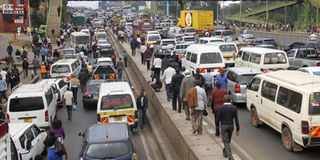Eight out of 10 Nairobians walk or use matatus to work: Report

Nairobi residents walk along Thika Superhighway after matatu operators went on strike citing increased parking fees by the county government.
The findings from the Kenya Institute for Public Policy Research Analysis (Kippra) on the Economic Growth of Nairobi County have underscored the importance of the matatu sector.
In its findings that were released on Friday, the government-funded research institute says that 58.7 percent (nearly six in every 10) of Nairobi residents use public service vehicles, better known as matatus to get to their places of work.
Further, the findings reveal that 17.1 percent (nearly two in every 10 )of the city residents walk to their places.
That means nearly 80 percent or eight out of 10 city residents either walk to work or use matatus.
Only 9.7 percent (about one in every 10 city dwellers) use private cars.
Those who use motorbikes stood at 3.9 percent, and buses at 3.7 percent.
This comes as about 10,000 matatus in the capital are plying different routes, some operating to the nearby counties.
The findings also indicate that matatu stops and routes are more and more accessible compared to rail, hence, making them the more convenient mode of transport for most Nairobi residents.
Travel destinations
“Many stops are concentrated in the central part of Nairobi, a sign of the fact that travel destinations are concentrated here as well. These destinations may include schools, work, home, social, shopping, businesses, or others,” the report says.
The findings also indicate that there is varying locational access to jobs for people living in various areas, which has led to spatial inequality.
According to the findings, while non-motorised modes of transport and PSVs are the predominant modes of transport, private car users have better access to employment opportunities.
“Using the overall average travel time per trip in Nairobi of 47 minutes, car users could access 58 percent of employment opportunities,” KIPPRA Senior Policy Analyst Dr Humphrey Njogu noted during the release of the findings.
Also, most jobs in Nairobi cannot be accessed by foot or minibus within an hour, and between 36-40 percent of the jobs accessible by foot are centrally located.
This means that the majority of jobs that can be accessed by minibus within an hour are located in the Nairobi city centre.
However, the trend is different in the eastern sides of the county, where different for job accessibility by car (70-100 per cent) of jobs are accessible by car in most parts of Nairobi, with lower shares in the east.
“In the far western part of Nairobi, where there are mostly poor unpaved roads, a lower number of jobs can be accessed by car, foot, or minibus,” he added.
The findings also show that traffic congestion affects accessibility by causing variability in travel speed and times.





